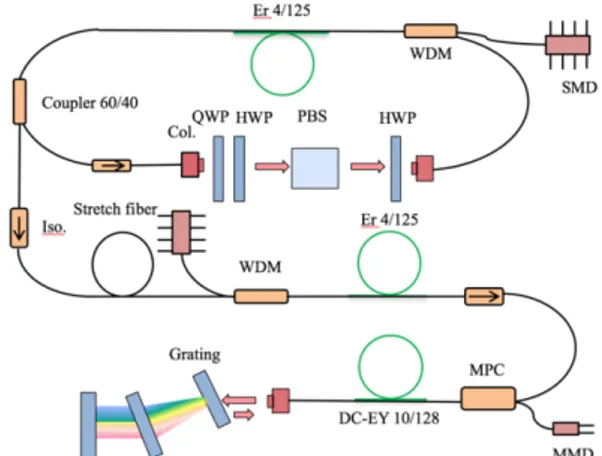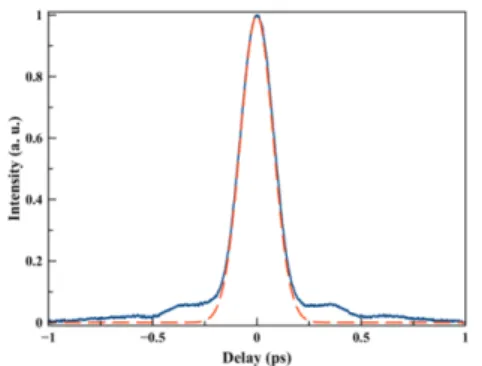Copyright @ IEEE
3.5-W, Femtosecond Chirped Pulse
Amplification Fiber Laser System at 1560 nm
Parviz Elahi
1, Huihui Li
1and F. Ömer Ilday
1,21Department of Physics, Bilkent University, Ankara, 06800, Turkey
2Department of Electrical and Electronics Engineering, Bilkent University, Ankara, 06800, Turkey
Abstract-We report a single-mode, 42 MHz, 3.5-W
average power chirped pulse amplification fiber laser system operating at 1560 nm. The laser system comprises a dispersion-managed mode-locked oscillator and two amplifier stages. The output pulses are compressed to 180 fs by using two diffraction gratings.
I. INTRODUCTION
There is much interest in development of ultra-short high power fiber laser systems due to their significant applications, especially in material processing [1]. Among them, Er-doped fiber laser is showing more attention in silicon processing and photovoltaic industries [2]. Thermal and nonlinear effects are the main limitation to achieve high power and high energy ultrashort pulses [3,4]. Heat generated in the fibers may damage the polymer and change thermos-optical properties of the gain medium [5]. Chirped pulse amplification (CPA) is the most common way to stablish high-power/high energy fiber lasers. I. Pavlov [7] demonstrated a 10-W average power EY-co-doped fiber laser system operating at 156 MHZ and compressed output pulses to 450 fs. Generation of 835-fs pulses with 8.65 W of average power, 50 MHZ repetition rate and 2.5-W average power, 390-fs pulses at 200 MHz are reported by G. Sobon [8,9].
Here, we demonstrate a CPA fiber laser system operating at 1560 nm. The system provides 3.5 W average output power at 42 MHZ pulse repetition rate. The pulses are compressed to 180 fs by using two compressor gratings.
II. EXPERIMENTAL SETUP
The schematic setup of the experiment is shown in Fig. 1. The seed source is a home-built dispersion-managed passively mode-locked oscillator delivering 5- ps long pulses at 42 MHZ repetition rate and 8 mW average power. We used 70-cm long positive dispersion fiber after the gain fiber (OFS, b2 =56.7 fs2
/mm) inside the oscillator to manage total dispersion delay of the cavity to achieve broad spectrum. The output from oscillator delivers to a 10-m long stretch fiber (OFS, b2 =56.7 fs2 /mm). 30-ps long output
pulses then delivers to the first amplifier, which consists of 1-m long Er 80-4/125 (CorActive) pumped
by a single-mode diode laser at 976 nm via a wavelength-division-multiplexer (WDM). The first stage amplifier generates 120 mW of average power. The spectral width is about 30 nm centred at 1560 nm. The power amplifier is based on 1.4-m long Er-Yb co-doped fiber with 10 µm core and 128 µm cladding diameter. The pump source is a 16-W wavelength-stabilized diode laser at 976 nm. The pump and signal are combined with a multimode pump signal combiner (MPC). A 10/128 fiber pigtailed collimator is used to collimate output beam.
Fig. 1 Schematic of setup. SMD, single mode diode laser; WDM, wavelength division multiplexer; Col, collimator; QWP, quarter wave plate; HWP, half wave plate; MPC, multimode pump-signal combiner; MMD, multimode diode laser.
The maximum average power achieved by the system before emerging Raman effect is 3.5 W. The output signal then delivers to a pair of diffraction grating with 900 line/mm line density for compressing.
III. RESULTS
The measured autocorrelation of the output pulse after compressing is shown in Fig. 2. The average power in this measurement is 3.5 W and the pulse energy is
Copyright @ IEEE Fig. 2. Measured autocorrelation (solid blue) and fitting with
Gaussian shape (dashed red).
83 nJ. The width is about 180 fs assuming Gaussian shape.Measured optical spectra of the power amplifier for two different output power levels, 2 W and 3.5 W are shown in Fig. 3
Fig. 3. Measured optical spectra at 2W (solid red line) and 3.5 W (solid red line) output power.
IV. CONCLUSION
In conclusion, we demonstrated a 3.5 W average power fiber laser at 1550 nm. The pulse repetition rate is 43 MHZ and are compressed to 180 fs by using compressor grating.
ACKNOWLEDGMENTS
This work was supported partially by TÜBITAK under project no. 115F098.
REFERENCES
[1] C. Kerse, H. Kalaycıoğlu, P. Elahi, B. Çetin, D. K Kesim, Ö. Akçaalan, S. Yavaş, Mehmet D. Aşık, B. Öktem, H. Hoogland, R. Holzwarth, F. Ö. Ilday, “Ablation-cooled material removal with ultrafast bursts of pulses,” Nature, 537 (7618), 84 (2016).
[2] O. Tokel, A. Turnali, G. Makey, P. Elahi, T. Çolakoğlu, E. Ergeçen, Ö. Yavuz, R. Hübner, M. Z. Borra, I. Pavlov, A. Bek, R. Turan, D.K. Kesim, S. Tozburun, S. Ilday, F.Ö. Ilday, “In-chip
microstructures and photonic devices fabricated by nonlinear laser lithography deep inside silicon,” Nat. Photon. 11, 639 (2017). [3] P. Elahi and N. Zare, “The analytical solution of rate equations in end-pumped fiber lasers with minimum approximation and temperature distribution during the laser operation,” Acta Physica Polonica A, 116 (4), 522 (2009).
[4] P. Elahi, S. Yılmaz, Ö. Akçaalan, H. Kalaycıoğlu, B. Öktem, Ç . Sȩenel, F. Ö. Ilday, K. Eken, “Doping management for high-power fiber lasers: 100 W, few-picosecond pulse generation from an all-fiber-integrated amplifier,” Opt. Lett. 37 (15), 3042 (2012). [5] H. Nadgaran and P. Elahi, “The overall phase shift and lens effect calculation using Gaussian boundary conditions and paraxial ray approximation for an end-pumped solid-state laser,” PRAMANA, 66(3), 513 (2006).
[5] I. Pavlov, E. Ilbey, E. Dülgergil, A. Bayri, and F. Ö. Ilday, “High-power high-repetition-rate single-mode Er-Yb-doped fiber laser system,” Opt. Express 20(9), 9471 (2012).
[6] G. Sobon, P. R. Kaczmarek, D. Sliwinska, J. Sotor, and K. Abramski, IEEE J. Sel. Top. Quant. Electron. High-power Fiber-Based Femtosecond CPA System at 1560 nm,” 20, 3100205 (2014). [7] G. Sobon, K. Krzempek, P. Kaczmarek, and K. Abramski, “An eye-safe, high-repetition rate single-mode femtosecond chirped pulse amplification system at 1560 nm,” Laser Phys. 23 075104 (2013).

